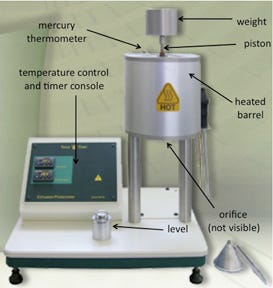Despite your protests, you probably don’t know all there is to know about MFR. This article will get you started down the path to enlightenment, leading to good parts.
March 23, 2011
Despite your protests, you probably don’t know all there is to know about MFR. This article will get you started down the path to enlightenment, leading to good parts.
While new developments in materials and processing technology are exciting, it is easy to lose sight of fundamentals in a world where the next big thing is always at the center of everyone’s attention. Recently, we spent a lot of time reviewing the subject of moisture analysis. This, in turn, is related to an important requirement for processing many polymers: drying the resin prior to molding.
|
Most processors recognize the need for drying, but a lot of attention to detail goes into ensuring adequately dried material, and many molders still resist the notion that it is important to document the various parameters associated with proper functioning of their drying equipment. I recently spoke with a client who was told by his molder that monitoring the dewpoint of their dryers was not necessary because they could “just tell by looking” whether or not the material was dry.
A similar lack of understanding is associated with melt flow rate (MFR) testing. Equipment for testing MFR has been around for almost as long as injection molding machines, but there is a tendency in the industry to view these devices, formally known as extrusion plastometers, as “old technology.”
Two-part solution 
to spiking MFR
Early in my career as a processor, our company received a rejection for brittle behavior in parts molded from clear polycarbonate (PC). The parts had an acceptable appearance and all critical dimensions were to print, but when the assembled product was subjected to a standard impact test, the parts we had molded cracked.
Samples of these parts were sent to the resin supplier and it was determined by MFR testing that the material had been degraded during the molding process. This conclusion was based on a comparison of the MFR of molded parts to the associated raw material. The raw material had an MFR of 10.2 g/10 min and the molded parts produced a result of 19.7 g/10 min—an increase of 93%.
During a visit by the technical representative from our resin supplier to evaluate the process, he explained that the MFR value was related inversely to the average molecular weight of the polymer. As the MFR increased, the average polymer chain length decreased. Shorter polymer chains provide less opportunity for chain entanglement, an important factor in ensuring adequate ductility in the material. Polycarbonate is thought of as a very impact-resistant material, but if not treated properly during processing, the polymer chains can be shortened excessively, resulting in brittle behavior.
As we reviewed the process to look for causes of the degradation, we focused on drying, the melt temperature of the material in the barrel and the hot runner, the time that the material spent in the molten state (often referred to as the residence time), and the management of regrind. If polymer degradation is occurring during processing, these are the factors that contribute to the problem. If more than one of these is out of bounds, the cumulative effect can be greater than the individual contributions. For example, wet material degrades much faster at a higher melt temperature than it will at a lower melt temperature.
As we went through the various aspects of the process, we identified two key areas of concern. One pertained to a need for more drying time when regrind was used. The customer allowed for a 20% level of regrind; however, the nonuniformity of the regrind particles as compared to the virgin pellets resulted in a less favorable surface-to-volume ratio. This meant that a longer drying time was needed to remove moisture from the material properly. Our dryers were sized to allow for only the minimum amount of drying time recommended, and this was insufficient when using regrind.
The other issue had to do with our hot runner. The placement of the thermocouples in our system resulted in temperature readings that were significantly lower than the actual temperature of the material in the system. By replacing the tip heaters with components that provided more accurate readings, we were able to set our temperatures in the runner system to a level that avoided overheating the material. Subsequent MFR tests saw the MFR of the molded parts drop to 12.4 g/10 min, an increase relative to the pellets of only 22%, and the impact test problems disappeared.
Demonstrate your own “touch of genius”
Such tutelage from resin suppliers is rare these days. But this experience inculcated a real awareness of how important molecular weight is in determining polymer properties. As a result, the first piece of equipment that went into our materials lab was an MFR tester. We didn’t even have to buy it; we found one gathering dust in the quality control lab. It had been purchased a few years earlier for the purpose of checking incoming lots of raw material with the idea that process variation could be traced to fluctuations in incoming material.
As we will show later, this was a poor application for the instrument. But the ability to correlate MFR results between a material supplier and a processor is inherently valuable, since it promotes better communication between supplier and customer and it creates an awareness within the molding operation of the importance of the measurement.
The instrument also provides a means of testing molded parts so that the molding process can be designed to ensure against polymer degradation, something that cannot be visually detected. Knowing the results of the process while parts are being made is far less costly than being blindsided by a report from a material supplier or an independent laboratory that informs you that the product you made and shipped months ago is not up to par.
Having worked with this method for most of a 35-year career, I am constantly surprised when I run into processors, many of them very capable and with good reputations in the industry, who do not understand the significance of the test and their role in its outcome. While MFR values appear on many material data sheets, the connection to molecular weight and the fact that this molecular weight can be influenced by process conditions seems to have eluded many practitioners in the industry. Sometimes the level of understanding is so poor that there is a refusal to believe the numbers, much less understand their significance.
In some ways, this is a curious symptom of our high-tech, data-cluttered world. We would rather monitor 14 parameters on our resin dryers than make an accurate measurement of the moisture content of the resin. We are drawn to a strategy for process control that records 64 variables rather than focus on the four or five that actually matter. We would rather do Six Sigma than simple SPC charting. But as Albert Einstein observed, “Any intelligent fool can make things bigger and more complex. It takes a touch of genius and a lot of courage to move in the opposite direction.” As it happens, in the long run, it also makes for a clearer and more straightforward understanding of the world around us. Bewilderment and hazy thinking cost money.
So as old as the topic of melt flow rate may be, experience suggests that we still need to understand and use it. In this series of articles, we will look at the significance of the measurement, shortcomings and limitations of the test, misconceptions about the technique, and details of obtaining good data from the instrument.
The MFR tester
|
Let’s start with what the instrument actually is and what it does. The photo shows a typical MFR tester. The hardware portion of the device consists of a heated chamber with a center bore into which the sample material is loaded. The diameter and finish of this bore are carefully spelled out in ASTM D 1238 or ISO 1133, both methods devoted to describing the procedures associated with the test. The set temperature for any given material is specified and can range from as low as 125°C to as high as 400°C, depending on the polymer being tested.
At the bottom of the cylinder is an insert called an orifice that contains an even smaller hole through which the molten material must pass. Once a sufficient amount of material has been loaded into the cylinder and properly compacted, it is preheated for a set amount of time to ensure that it has been uniformly heated. Although a temperature control is used to set the appropriate temperature, an actual thermometer designed to read very small changes in the target temperature is also placed into a hole in the heated chamber to confirm that the correct temperature is achieved. In older instruments, mercury thermometers were used as the only temperature reading. In the newer instruments being built today, the physical thermometer is often used simply as a calibration tool for the digital readout.
A piston weighing 100g is then inserted into the cylindrical bore of the instrument from the top side and a weight is placed on top of the piston to achieve the specified constant load. This constant load is also a material-specific parameter. Whenever an MFR value is quoted, it should be accompanied by a notation that specifies the temperature and the load used in performing the test. This is important because, for better or worse, many materials can be tested at multiple conditions. As we have discussed in a previous article, the selected conditions for a given resin can have a substantial influence on the numbers obtained.
Once the prescribed preheat time has been achieved, the test is started. It can be run in one of two ways. One method involves a constant time. Material being pushed out of the orifice by the force of the constant load applied from above is collected at regular intervals specified by the method, and the mass of these samples is converted to a result given in g/10 min.
An alternative method involves extruding a fixed volume of material, regulated by a sensor that starts the timer at a fixed point in the travel of the piston and stops it once the piston has traveled a particular distance. The conversion of the raw data into the MFR result is a little more complicated using this approach, but it also allows for the calculation of a melt volume flow rate (MVR), if necessary. This approach is becoming more popular with material suppliers, and if you are going to make an apples-to-apples comparison with a certification supplied by a supplier that uses MVR measurements, it pays to speak the same language.
The volumetric flow rate is actually a parameter that is more relevant to a determination of the viscosity of the polymer. It factors out differences that may be due only to the density of the material. And being able to perform the test in this way enables the measurement of melt density. This is an important parameter for flow simulation software and it has some interesting and little-understood applications for determining the shot capacity of a molding machine that we will review later.
So this, in a nutshell, is how the device works. In the next part of our article we will discuss some details of sample preparation, some housekeeping considerations, and start to look at how the device should be used and, perhaps more importantly, how it should not be used.
About the Author(s)
You May Also Like




